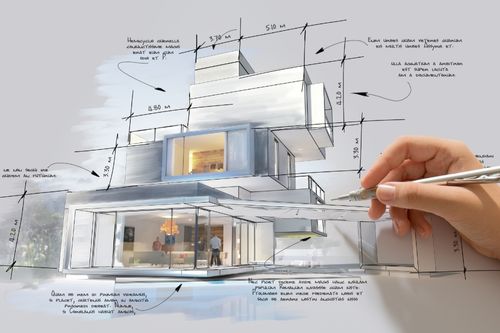Comprehending the Collaborative Refine In Between Designers and Engineers in Modern Construction Projects
The collective procedure between designers and designers is vital in modern-day building tasks, as it harmonizes style intent with design feasibility. Checking out these characteristics reveals insights that can significantly affect task outcomes and general market standards.
The Value of Cooperation
The collaborative synergy in between engineers and designers is important for the effective understanding of any kind of construction job. This partnership brings with each other distinctive experience and perspectives, enabling the combination of ingenious style with sensible design solutions. By working together, engineers and engineers can make certain that a task not just fulfills visual and useful needs yet additionally follows safety, sustainability, and budgetary constraints.
Partnership promotes a shared vision, helping with the positioning of goals and expectations from the outset. This alignment is crucial in addressing potential obstacles and mitigating threats that can emerge throughout the job lifecycle. Additionally, a collective method enables the reliable appropriation of sources, enhancing both time and cost.
The importance of cooperation reaches the iterative process of layout and building, where feedback from designers can notify architectural choices, resulting in even more practical and sustainable layouts. On the other hand, architects can motivate engineers to think creatively concerning how to achieve architectural stability without endangering creative intent. Ultimately, the collective relationship in between engineers and designers is not just advantageous; it is basic to the creation of premium, functional, and ingenious constructed environments that fulfill the requirements of society.
Interaction Methods and Tools
Efficient communication techniques and devices are important for fostering collaboration in between architects and engineers throughout the task lifecycle. Establishing clear channels of interaction is important to guarantee that all staff member are lined up with task objectives, timelines, and obligations. Normal meetings, both in-person and online, supply opportunities for stakeholders to discuss development, address worries, and make educated decisions.
Utilizing job monitoring software, such as BIM (Building Info Modeling) systems, boosts cooperation by enabling real-time sharing of style alterations and technological requirements. These tools facilitate transparency, enabling designers and engineers to picture adjustments and analyze their influence on the overall project.

Shared Goals and Task Vision
:max_bytes(150000):strip_icc()/Buildingdesigns-GettyImages-912482942-db55b3af711044a3a42ad1040c6711a9.jpg)
Establishing shared objectives involves open discussion and a comprehensive understanding of each technique's contributions. Designers normally focus on style intent, spatial partnerships, and user experience, while engineers highlight architectural integrity, systems performance, and conformity with laws (cda architects). When these perspectives are lined up, the outcome is a natural task that complies with both innovative ambitions and technological usefulness
Furthermore, a well-defined job vision cultivates liability among staff member, motivating each participant to take possession of their duty in achieving the preferred outcome. Regular check-ins and collaborative workshops can even more strengthen this commitment, enabling for modifications to be made as the job evolves. Eventually, a shared vision not only improves team effort yet also boosts the quality of the final deliverable, causing successful job conclusion.
The Function of Innovation
Leveraging technology has actually become necessary in boosting partnership between designers and designers. Structure Details Modeling (BIM) stands out as a pivotal innovation, enabling both designers and designers to produce thorough 3D versions that envelop design intent and structural integrity.
Furthermore, cloud-based platforms allow seamless partnership, enabling job stakeholders to gain access to and upgrade job data from anywhere. This promotes a culture of transparency and responsibility, as modifications can be tracked and evaluated in original site real-time. Furthermore, mobile applications additional enhance communication, providing on-site teams with immediate accessibility to task requirements and updates.
Arising innovations such as expert system and device knowing are also starting to play a duty in anticipating analysis, helping groups recognize prospective problems before they emerge. Inevitably, the function of technology in architecture-engineering partnership not only improves workflow effectiveness yet also boosts advancement, resulting in more effective job outcomes. By welcoming these technical developments, designers and engineers can ensure an extra cohesive and effective collective process throughout the building and construction lifecycle.
Instance Studies in Effective Partnerships
Numerous study highlight the profound influence of effective collaborations between engineers and engineers on task results. One remarkable example is the cooperation on the High Line in New York City, where landscape engineers, engineers, and metropolitan planners functioned with read this post here each other to transform a deserted railway right into a vibrant public park. This multidisciplinary strategy not only improved the aesthetic high quality yet also made sure structural security and ecological sustainability.
Another exemplary situation is the layout and construction of the Sydney Concert Hall. The collaboration in between engineer JÃ ¸ rn Utzon and structural designer Ove Arup exhibited innovative analytical. Their cooperation permitted the renowned shell-like style while resolving complex engineering obstacles, eventually causing a classic building masterpiece.
The Burj Khalifa in Dubai even more demonstrates the relevance of joint initiatives. cda architects. The assimilation of architecture and engineering experience enabled the project team to achieve unmatched heights while adhering to security guidelines and visual vision
These instances emphasize the relevance of interaction, trust fund, and shared purposes. In today's intricate building and construction setting, such collaborations are necessary to navigating challenges and supplying tasks hop over to here that meet both functional and visionary objectives.
Verdict
In conclusion, the collaboration between designers and engineers is crucial for the success of contemporary construction tasks. Reliable communication strategies, a shared task vision, and the combination of advanced innovations are crucial parts that facilitate this collaboration.